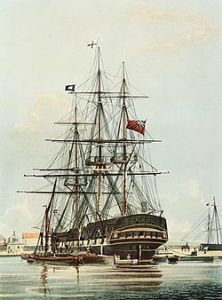
Ships fly a flag of convenience in order to avoid the regulatory arms of the state or transnational institutions. But here is a fascinating colonial precedent to the flag of convenience – from 1674:
Thus, when the [East India Company] committees insisted in 1674 that a new Admiralty regulation, which required all English commercial shipping to fly only the English merchant flag, should not apply to Company ships within the boundaries of its charter, they and the Admiralty under Samuel Pepys [seriously?] reached a compromise: Company captains would simply switch their flag for the English “red ensign” when outside of the East Indies. The point specified for the transition, however, was not the Cape of Good Hope but St. Helena. While contemporary maps might have located the island geographically in the Atlantic or Africa, for the Court of Committees [of the East India Company] it quite clearly was situated conceptually and jurisdictionally “in India.” (Philip Stern, The Company-State: Corporate Sovereignty and the Early Modern Foundations of the British Empire in India, p. 42)
This flag of convenience mattered to the East India Company, because India was the milieu of its monopolistic corporate sovereignty.

So which regulatory restrictions or transnational institutions were being avoided by the use of the Company’s own flag?
The blog post gives the impression that this was vaguely illegitimate, exploitative, and even sinister, but as the uninitiated I don’t see how that’s the case.
Or is it just that the mind works in mysterious ways and draws links between unrelated things?
A ship that is not flagged to one of the highly regulated states (e.g. EU) tends to have far more terrible working conditions for their workers than one of the European-flagged ships. That means that the same company have vastly varying conditions of work on different ships depending on where the ship is flagged.
See the ITF’s campaign against flags of convenience which explains the working conditions on a ship with flags of convenience: http://www.itfglobal.org/en/transport-sectors/seafarers/in-focus/flags-of-convenience-campaign/
My sense is also that flags of convenience also avoid environmental regulations. Certainly a ship flagged to Panama or Liberia or Cyprus often looks more like a rust-bucket than one flagged to Europe. (see for example this report about ships with FOC engaging in illegal fishing: http://ejfoundation.org/sites/default/files/public/Lowering%20the%20flag.pdf)
As for “the mind working in mysterious ways” and connecting unrelated things – is there really a need to be rude when asking a question?